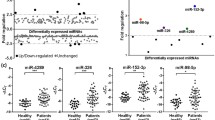Abstract
In addition to their potential as tissue-based markers for cancer classification and prognostication, the study of microRNAs (miRNAs) in blood circulation is also of interest. In the present study, we investigated the amounts of three cancer-related miRNAs, miR-21, -141, and -221 in blood plasma of prostate cancer (PCa) patients. A cohort of 51 patients with PCa was enrolled into the study, and miRNAs were measured in two subgroups, with localized/local advanced or metastatic PCa. A group of 20 healthy individuals served as the control group. miRNAs were quantified from the total RNA fraction using 200 μl plasma and the small RNA molecule RNU1A as a control for normalizing the miRNA amounts in circulation. We found similar levels of three miRNAs in healthy subjects with median values of 0.039, 0.033 and 0.04, respectively; (p = n.s.). In the patients, the miRNA levels were higher, with miR-21 being the highest (median, 1.51). The miR-221 levels were intermediate (median, 0.71) while the miR-141 displayed the lowest levels (median, 0.051). The differences between the control group and the patients were highly significant for the miR-21 (p < 0.001; area under the curve (AUC), 88%) and -221 (p < 0.001; AUC, 83%) but not for the miR-141 (p = 0.2). In patients diagnosed with metastatic PCa, levels of all three miRNAs were significantly higher than in patients with localized/local advanced disease where the difference for the miR-141 was most pronounced (p < 0.001; AUC, 75.5%). In conclusion, analysis of miR-21, -141, and -221 in blood of PCa patients reveals varying patterns of these molecules in clinical subgroups of PCa.



Similar content being viewed by others
References
Hayat MJ, Howlader N, Reichman ME, Edwards BK. Cancer statistics, trends, and multiple primary cancer analyses from the Surveillance, Epidemiology, and End Results (SEER) Program. Oncologist. 2007;12:20–37.
Sboner A, Demichelis F, Calza S, Pawitan Y, Setlur SR, Hoshida Y, et al. Molecular sampling of prostate cancer: a dilemma for predicting disease progression. BMC Med Genomics. 2010;3:8.
Roberts WW, Bergstralh EJ, Blute ML, Slezak JM, Carducci M, Han M, et al. Contemporary identification of patients at high risk of early prostate cancer recurrence after radical retropubic prostatectomy. Urology. 2001;57:1033–37.
Ferracin M, Veronese A, Negrini M. Micromarkers: miRNAs in cancer diagnosis and prognosis. Expert Rev Mol Diagn. 2010;10:297–308.
Volinia S, Calin GA, Liu CG, Ambs S, Cimmino A, Petrocca F, et al. A microRNA expression signature of human solid tumors defines cancer gene targets. Proc Natl Acad Sci. 2006;103:2257–61.
Ambs S, Prueitt RL, Yi M, Hudson RS, Howe TM, Petrocca F, et al. Genomic profiling of microRNA and messenger RNA reveals deregulated microRNA expression in prostate cancer. Cancer Res. 2008;68:6162–70.
Porkka KP, Pfeiffer MJ, Waltering KK, Vessella RL, Tammela TL, Visakorpi T. MicroRNA expression profiling in prostate cancer. Cancer Res. 2007;67:6130–35.
Ozen M, Creighton CJ, Ozdemir M, Ittmann M. Widespread deregulation of microRNA expression in human prostate cancer. Oncogene. 2008;27:1788–93.
Schaefer A, Jung M, Kristiansen G, Lein M, Schrader M, Miller K, et al. MicroRNAs and cancer: current state and future perspectives in urologic oncology. Urol Oncol. 2010;28:4–13.
Mitchell PS, Parkin RK, Kroh EM, Fritz BR, Wyman SK, Pogosova-Agadjanyan EL, et al. Circulating microRNAs as stable blood-based markers for cancer detection. Proc Natl Acad Sci. 2008;105:10513–18.
Kosaka N, Iguchi H, Ochiya T. Circulating microRNA in body fluid: a new potential biomarker for cancer diagnosis and prognosis. Cancer Sci. 2010;10:2087–92.
Lodes MJ, Caraballo M, Suciu D, Munro S, Kumar A, Anderson B. Detection of cancer with serum miRNAs on an oligonucleotide microarray. PLoS ONE. 2009;4:e6229.
Tanaka M, Oikawa K, Takanashi M, Kudo M, Ohyashiki J, Ohyashiki K, et al. Down-regulation of miR-92 in human plasma is a novel marker for acute leukemia patients. PLoS ONE. 2009;4:e5532.
Heneghan HM, Miller N, Kelly R, Newell J, Kerin MJ. Systemic miRNA-195 differentiates breast cancer from other malignancies and is a potential biomarker for detecting noninvasive and early stage disease. Oncologist. 2010;15:673–82.
Brase JC, Johannes M, Schlomm T, Fälth M, Haese A, Steuber T, et al. Circulating miRNAs are correlated with tumor progression in prostate cancer. Int J Cancer. 2011;128:608–16.
Ribas J, Lupold SE. The transcriptional regulation of miR-21, its multiple transcripts, and their implication in prostate cancer. Cell Cycle. 2010;9:923–29.
Galardi S, Mercatelli N, Giorda E, Massalini S, Frajese GV, Ciafrè SA, et al. miR-221 and miR-222 expression affects the proliferation potential of human prostate carcinoma cell lines by targeting p27Kip1. J Biol Chem. 2007;282:23716–24.
Mercatelli N, Coppola V, Bonci D, Miele F, Costantini A, Guadagnoli M, et al. The inhibition of the highly expressed miR-221 and miR-222 impairs the growth of prostate carcinoma xenografts in mice. PLoS ONE. 2008;3:e4029.
Umetani N, Hiramatsu S, Hoon DS. Higher amount of free circulating DNA in serum than in plasma is not mainly caused by contaminated extraneous DNA during separation. Ann NY Acad Sci. 2006;1075:299–307.
Baffa R, Fassan M, Volinia S, O’Hara B, Liu CG, Palazzo JP, et al. MicroRNA expression profiling of human metastatic cancers identifies cancer gene targets. J Pathol. 2009;219:214–21.
Acknowledgements
This work was supported by Istanbul University Research Fund (Project no. 7986).
Author information
Authors and Affiliations
Corresponding author
Rights and permissions
About this article
Cite this article
Yaman Agaoglu, F., Kovancilar, M., Dizdar, Y. et al. Investigation of miR-21, miR-141, and miR-221 in blood circulation of patients with prostate cancer. Tumor Biol. 32, 583–588 (2011). https://doi.org/10.1007/s13277-011-0154-9
Received:
Accepted:
Published:
Issue Date:
DOI: https://doi.org/10.1007/s13277-011-0154-9




